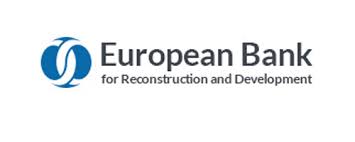How working together for greener cities can help save the planet.

The EBRD’s Terry McCallion at a Brussels gathering of the Covenant of Mayors
Urban rivers choked with plastic, exhaust fumes hazing up the sunset over traffic jams, industrial chimney stacks belching smoke, or decrepit old housing leaking heat into the sky … Cities – the source of 70 per cent of energy use and 80 per cent of greenhouse gas emissions worldwide – are where most of the world’s pollution happens.
In an age of growing concern over where climate change and environmental degradation might lead, cities therefore also represent one of the greatest opportunities to address these challenges. As a result, perhaps paradoxically, they are fast taking on another role - as centres for creative thinking about how best to green the planet.
One such meeting of minds took place in Brussels on 19-20 February. Organised by the Covenant of Mayors, the world’s largest movement for local climate and energy actions, it brings together multiple organisations and individuals working, in different ways, towards the same climate action goals.
“Cities are the fora for fast and effective climate action,” said one speaker at the event, the European Bank for Reconstruction and Development’s Terry McCallion. “And partnerships with other organisations working in the urban space are essential.”
McCallion, the EBRD’s Director of Energy Efficiency and Climate Change, added: “local and regional authorities play a pivotal role in achieving transition toward a more decentralised, energy-efficient, decarbonised and resilient energy system.”
He should know. The EBRD has worked with many partners to develop the EBRD Green Cities programme. They includethe Organisation for Economic Cooperation and Development (OECD), ICLEI (a sustainability association of 1,500 local governments), the Covenant of Mayors and the Global Platform for Sustainable Cities, which brings together international financial organisations, United Nations organisations and other urban research and advocacy groups to share their experiences in urban environmental evaluation, planning and investment.
The global Paris Agreement of 2015 sets the big goals for today’s climate action – keeping the worldwide temperature rise to under 2C and if possible to 1.5C by reducing greenhouse gas emissions. But actually implementing the practical changes that will make this reality happens at a city level, where relatively local authorities are looking for the best ways to address specific environmental issues and improve the quality of life of their residents.
So imaginative climate action programmes for city-level participants have been springing up everywhere, tapping into the zeitgeist. So strong is the pent-up demand for their bottom-up or locally focussed approach to what might otherwise seem an unmanageably abstract challenge that they tend to grow faster than they could have imagined on Day One.
The Covenant of Mayors is one star. It brings together thousands of local governments voluntarily committed to implementing EU climate and energy objectives. Launched in 2008 in Europe, its success quickly went beyond expectations. It has since grown to include more than 7,000 local and regional authorities across 57 countries, not just in Europe but around the Mediterranean, in North America, Latin America and the Caribbean, China and South-East Asia, India, Japan, and sub-Saharan Africa.
The ambitious EBRD Green Cities programme, which brings one institution’s long experience to bear on making tangible change in today’s urban environments, has likewise proved so popular that since being established in 2016 it has quadrupled in size. Over €1 billion of EBRD and donor funding facilities have been approved for projects expected to be developed in future under the programme. . It now counts 20 cities fromBulgaria, to Jordan to Mongolia.
The EBRD programme builds on a wealth of knowledge acquired over decades. The bank, which came into existence more than a quarter-century ago to bring private sector market practices to the formerly communist states on the eastern side of Europe, has unique experience of working in cities where obsolete urban infrastructure has been degrading the quality of life of citizens, increasing greenhouse gas emissions, and preventing communities from adapting to climate change.
Since 1994 the bank has invested over €8 billion in the municipal sector in over 450 projects, working with more than 220 cities, giving the institution unique expertise in addressing urban challenges.
Today, both the EBRD and Covenant of Mayors, which coordinate regularly, talk the same sort of climate action language.
Cities that sign up to EBRD Green Cities each formulate their own Green City Action Plan, or GCAP, to set out a plan for investments and policy changes over several years that will take them towards a cleaner urban lifestyle.
Cities signing up to the Covenant of Mayors initiative promise to support the EU greenhouse gas reduction target of 40 per cent by 2030 and to adopt a shared approach to doing this. Each signatory then writes and adopts a Sustainable Energy and Climate Action Plan, or SECAP, measuring emissions by sector and climate risks, and setting out what to cut, and how.
“The GCAP and the SECAP both seek to use environmental and climate information to drive city investment and policy decision making,” McCallion explained.
Yet each of the two institutions brings a different accent to the shared language.
While a SECAP focuses on reducing greenhouse gas emissions by a specific percentage, in line with the EU targets, a GCAP can look more broadly at air pollution and water pollution, works on infrastructure issues in sectors like solid waste or water and wastewater, and is more investment focused. A GCAP involves rounds of stakeholder engagement to identify a city’s five-year plan, and may identify potential sources of finance for each of the actions listed too.
Despite the differences in approach, what these two programmes share is a workload of city-level tasks that are virtuous if not always, in themselves, especially dramatic or glamorous.
The EBRD way involves a lot of painstaking work on gritty city detail. One EBRD initiative lends money to local banks to on-lend to individuals to insulate their homes better and, on a slightly bigger scale, helps local government make office buildings more energy-efficient. The bank supports local administrations and transport companies to buy and run less polluting public transport (swapping out diesel buses for something greener, say). It shares know-how between cities on updating wastewater or district heating plants, often so as to diversify the sources of energy that power them away from the dirtier fossil fuels, and, hopefully, bring more renewable energy into the mix to replace them.
That there is potentially a need for more than one approach is shown by the city of Belgrade, which is simultaneously developing both a SECAP and a GCAP. “EBRD Green Cities is complementary to the work of the Covenant of Mayors,” said McCallion.
He added: “It’s working together, paying attention to the detail and focusing on results that will deliver real climate progress
21 February 2019



